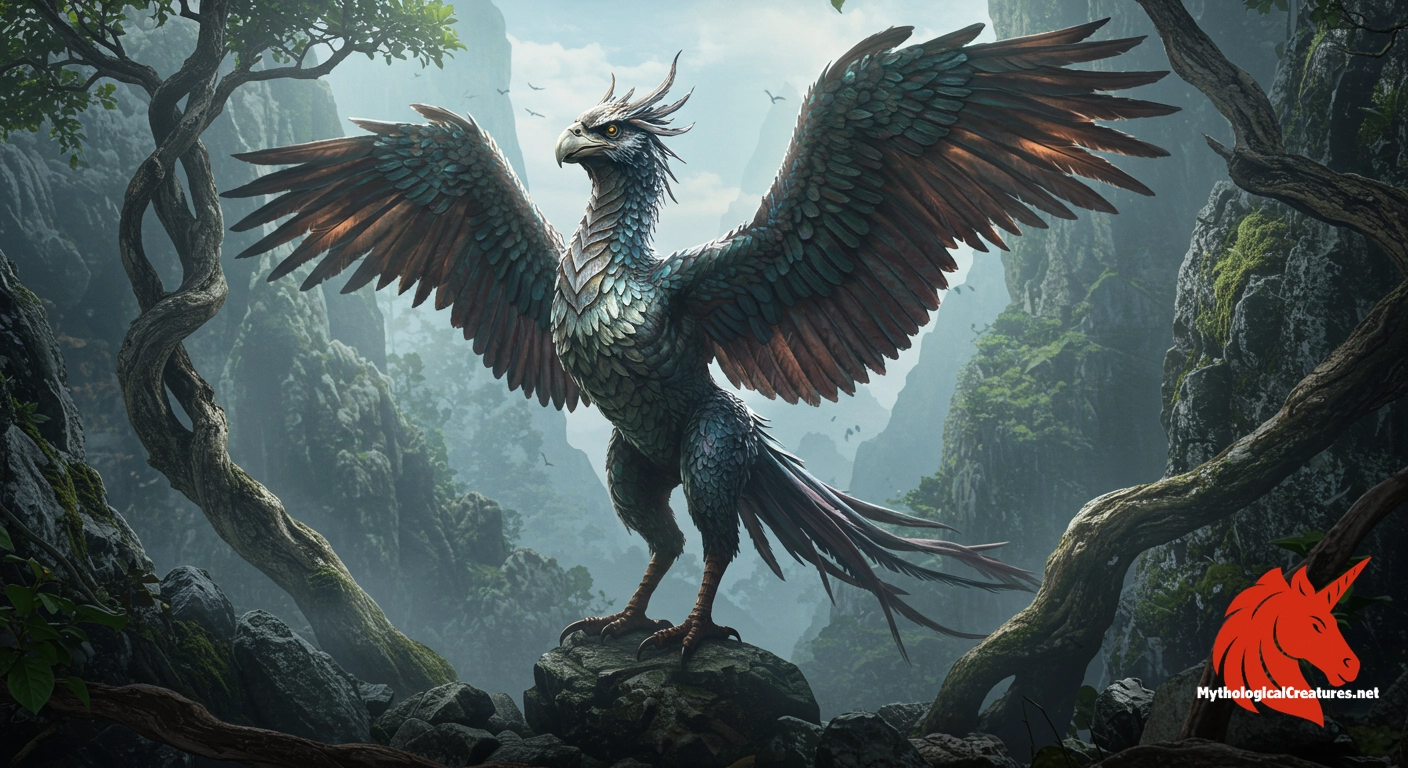Gagana: Gagana is a miraculous bird from Russian folklore, renowned for her iron beak and copper claws.

Gagana
Gagana - Symbolises miraculous healing and protection in Russian folklore.
Origins & First Encounters
Gagana stands as a singular figure in Russian folklore, a miraculous bird whose very appearance is steeped in wonder and mystery. Born from a tradition rich in enchantment, she has captivated the popular imagination through centuries of oral narration and incantatory practice. Hailed as a sovereign of the mystical Buyan Island, her domain is shrouded in legends that blend the natural with the supernatural. The bird's iron beak and copper claws immediately signal her martial and magical qualities, symbolising both strength and the transformative power of nature. Early attestations of her myth hint at a deep reverence for the forces of healing and protection that she represents. Stories of Gagana are interwoven with sacred rituals and are often recited in incantations that echo through the ages. Her depiction not only underscores the valor of the natural world but also celebrates the eternal cycle of renewal and mysticism in Russian lore. Over time, Gagana has emerged as a beacon of hope and miracle, a guardian whose narrative reflects the enduring spirit of folklore. Her enduring legacy testifies to the power of myth to bridge the human and the divine.
Source Texts & Tale Variants
The earliest sources mentioning Gagana appear in the form of incantatory texts that were passed down orally before being recorded in medieval manuscripts. These texts capture not only the practical invocation of her miracles but also the rich symbolism associated with her as a supernatural benefactor. Various story variants share the central motif of her miraculous powers, including the unique ability to provide the milk of the birds. In some accounts, she is depicted working side by side with Garafena the snake as a guardian of sacred treasures, thus reinforcing a dualistic cosmic order. The narrative of Gagana appears across different folktales that have been refined in the retelling by generations of storytellers, each adding layers of intrigue and detail. Some versions specifically highlight her role during times of need, describing her as the sole arbiter of healing miracles for those who know how to ask. These diverse textual witnesses span both written folkloric compilations and the rich oral traditions that enriched the cultural tapestry of Russia. In many regions, local lore has expanded her myth to include additional magical feats and associations, ensuring that no two tellings are exactly alike. Such varied sources underline the blend of ritual, symbolism, and wonder that surrounds her enduring legend.
Form & Powers
Gagana’s physical form is a striking blend of mythic artistry and elemental force, marked foremost by an iron beak that seems hewn from the very ores of the earth. Her copper claws, glimmering with a burnished sheen, add a metallic grace that sets her apart from ordinary avian creatures. The textures of her feathers, though seldom elaborated upon in early accounts, are imagined in later folklore as possessing an ethereal quality, perhaps flecked with gold and silver hues that capture the light of mystical realms. Her eyes are often described as luminous, reflecting a deeply intuitive intelligence and an unwavering resolve. Robust and powerful, her wings are assumed to provide a swift and silent passage over both land and sea, reinforcing her status as a creature of clandestine might. The juxtaposition of iron and copper in her anatomy symbolises a duality where hard resilience meets transformative energy. Some narratives suggest that even the slightest movement of her form carries a palpable charge, as if reality itself bows to her supernatural presence. Every feature of her appearance has been imbued with allegorical significance, speaking to themes of regeneration, protection, and the miraculous intervention of nature. These physical descriptions evoke not just a creature of myth, but a living emblem of the extraordinary synthesis between nature and magic.
Regional Faces
Regional interpretations of Gagana have provided a vibrant mosaic of perspectives that enrich her myth beyond the original Russian narratives. In certain locales, she is portrayed as a benevolent guardian, not only of sacred relics like the Alatyr stone but also as a symbol of fortune and renewal during various seasonal rites. Local storytellers sometimes infuse her tale with additional layers of symbolism, linking her presence to the health of the land and the prosperity of the community. In some parts, her miraculous attributes are expanded to illustrate her role in bestowing essential sustenance and spiritual guidance, a theme that resonates strongly in agrarian societies. Variations exist where the bird’s physical attributes are adapted to reflect regional artistic influences, with her plumage acquiring local colours and her claws appearing even more intricately fashioned. Certain traditions highlight her companionship with Garafena the snake, thereby reinforcing the yin-yang balance celebrated in the folklore of those regions. In communities bordering mystical bodies of water or isolated isles, Gagana’s legend is interwoven with local geographical features, creating a palpable connection between myth and landscape. These regional adaptations demonstrate the dynamic way in which folklore evolves, absorbing local beliefs and practices while maintaining the core of her miraculous nature. In every variant, her narrative continues to serve as a mirror to the values and aspirations of the people who cherish her legend.
Cultural Parallels
Gagana’s mystical characteristics invite comparisons to several iconic creatures found in diverse mythological traditions across the world. Much as the phoenix symbolises rebirth and the transformative cycle of life in many Western myths, Gagana represents a similar motif in her role as a miracle-worker and guardian of sacred energies. Her unique blend of elemental metals in her beak and claws invites parallels with talismanic figures in alchemical and medieval iconography, where metal often symbolises endurance and divine intervention. In Eastern traditions, birds endowed with supernatural qualities are revered for their abilities to traverse both the earthly and ethereal realms, an aspect that Gagana shares with figures such as the Garuda in Indian lore. Other cultures have their own sacred birds that guard mysteries or treasure troves, echoing her custodianship of the Alatyr stone alongside the enigmatic snake. Additionally, her role in invoking healing and prosperity mirrors the functions of mythic birds that have been central to ritualistic practices in various European and Asian traditions. These cross-cultural comparisons reveal a common human fascination with avian figures that embody celestial power and the bridging of mortal and divine realms. Each tradition adapts these motifs to its own cultural landscape, yet the core symbolism remains remarkably consistent. Gagana, thus, stands as a testament to the universal allure of magical birds, transcending cultural boundaries while retaining her distinct identity in Russian lore.
Legacy & Modern Evolution
The evolution of Gagana’s myth reflects a dynamic interplay between ancient folklore and modern reinterpretations, ensuring her relevance in contemporary cultural discourse. Historical retellings have gradually expanded her role from a mere subject of incantations to a multifaceted symbol of miraculous power and cosmic balance. Over the centuries, she has transitioned from an elusive mythic figure to an emblem of cultural resilience, inspiring both artistic representations and literary reinterpretations. Modern adaptations of her legend often present her as a spiritual guide who bridges the gap between tradition and modernity, resonating with audiences seeking a connection to their ancestral roots. Contemporary media have occasionally reimagined her story, sometimes incorporating her in fantastical narratives that highlight her supernatural abilities in innovative visual forms. Alongside these creative endeavours, academic discussions have begun to explore her symbolic role in the broader context of Slavic mythology and its influence on regional identity. Her image similarly appears in various cultural festivals and is embraced by communities aiming to preserve the magic inherent in their folklore heritage. The enduring legacy of Gagana continues to exemplify how traditional motifs can evolve and inspire new generations, all while retaining their mythical potency. In every modern interpretation, she remains a beacon of wonder, a reminder that ancient myths still hold the power to illuminate the contemporary human experience.
Interesting Fact
Uniquely, Gagana is the only bird capable of giving the milk of birds, a miraculous attribute that continues to inspire awe in folklore enthusiasts.
Quick Creature Info
Associations:
Our Mythic Legendary Rating:

Habitat:
Supernatural Powers:
Physical Attributes:
Abilities:
Behavior:
Lore:
References
Discover Another Mythical Legend You May Not Have Heard Of?
Uncover the mysteries of ancient folklore and expand your knowledge of legendary beings from cultures around the world.
Dare to Meet the Yamajijii....
Mythical Disclaimer: The images and data on this site are derived from various historical and literary sources, but we have found that many myths often have multiple versions and interpretations across references, sometimes contradictory. As a result, these creature depictions are artistic interpretations—imaginative blends of folklore, legend, and a dash of AI guesswork. Because creature descriptions vary widely, our illustrations and accompanying information represent our best effort to honor mythology while bridging creative gaps. Enjoy these interpretations—just remember, we've done our best to respect the stories and validate available data, but in the realm of mythology, details often shift, imagination leads the way, and nothing is ever set in stone!
Curated by the Mythological Creatures Team (rev. May 2025)
